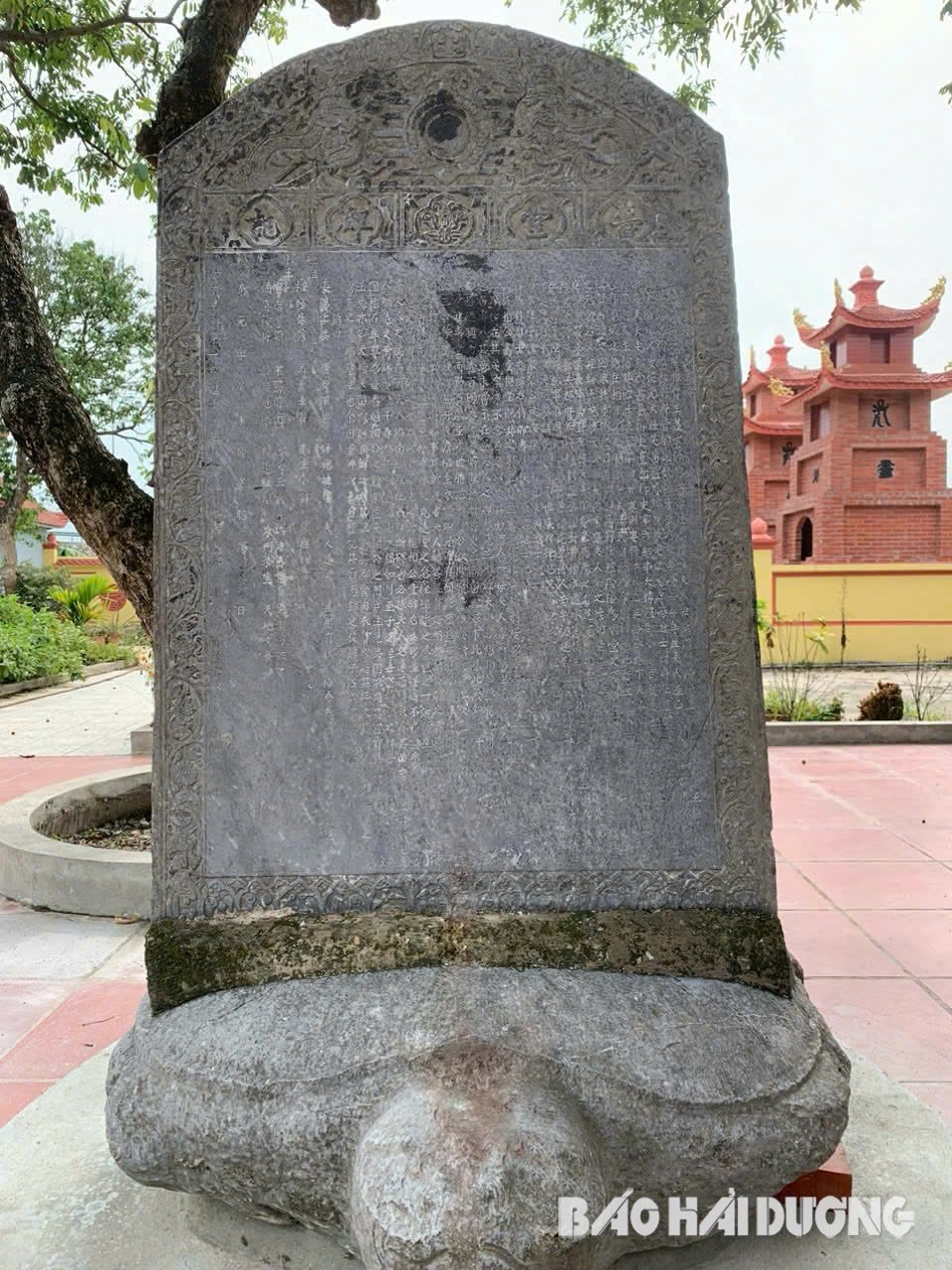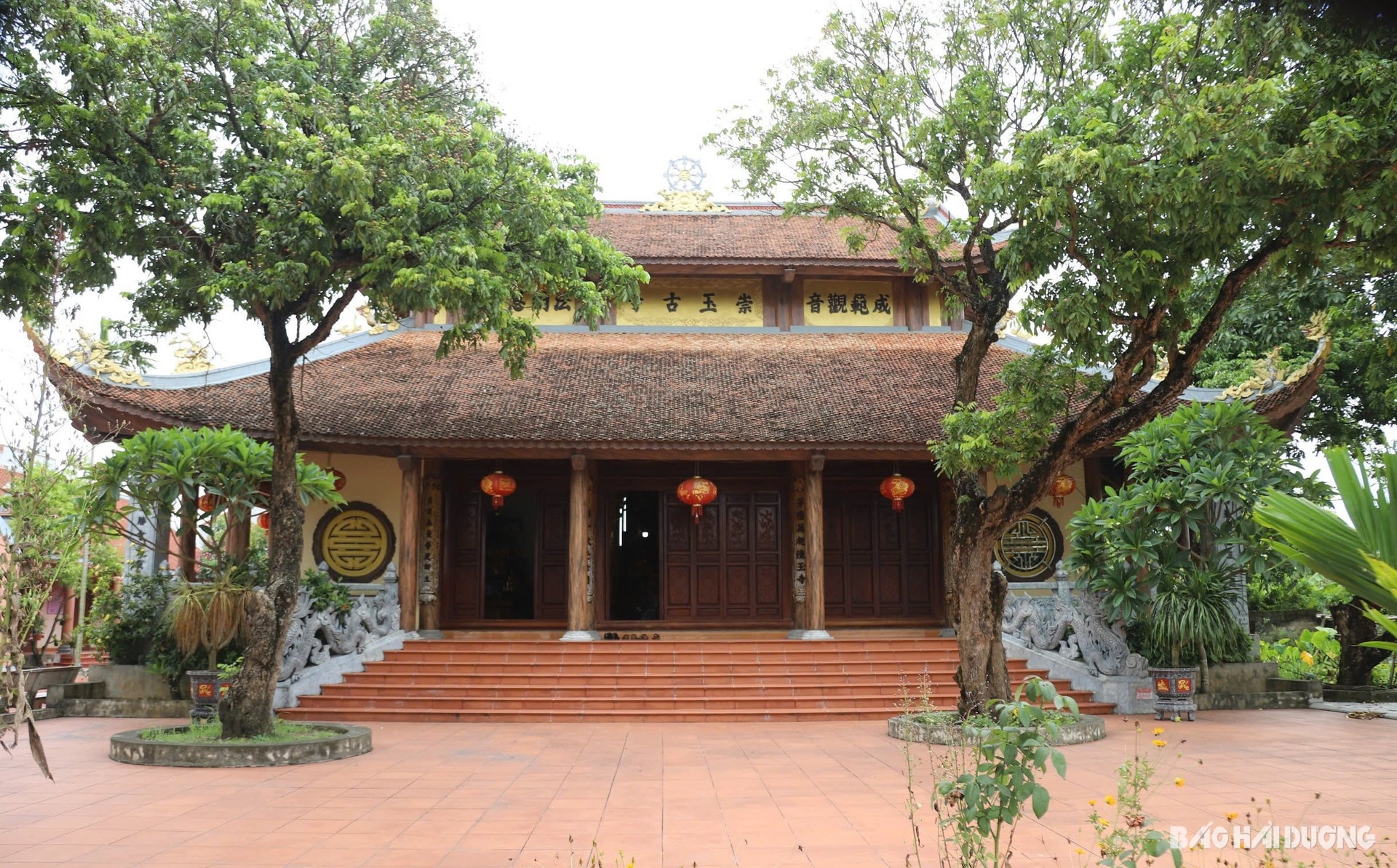The stele engraved with the merits of Nghe An doctor Nguyen Van Giai is being kept at Ngoc Mai pagoda, Vinh Hung commune, Binh Giang (Hai Duong).

Imprint with Ngoc Mai land
The stele named "Ngoc Mai village worshiping - Tho Duong bi ky" was erected in the year Phuc Thai (1643), and is currently kept at Ngoc Mai pagoda (also known as Sung Ngoc pagoda) in Vinh Hung commune, Binh Giang district.
The stele is erected on the back of a turtle and placed in the front yard of the temple. It measures (113 x 81 x 11) cm, with about 2,000 characters. The stele name is placed in a stylized banyan leaf box. The stele is carved in the Le Dynasty style. The forehead of the stele is engraved with the image of "two dragons facing the sun". The body of the stele is carved with graceful and elegant chrysanthemum flower and leaf strings, and the border is stylized lotus petals arranged together.
Both sides of the stele are engraved with Chinese characters. The front of the stele contains an introduction to the life and career of Dr. Nguyen Van Giai and his wife. Accordingly, his wife's family name is Vu, her given name is Mien, from Ngoc Mai village, Ha area, Duong An district, Thuong Hong prefecture, Hai Duong province. Mrs. Mien is the daughter of the General of the Admiralty, Vu Ky, her mother is also from the family name Vu. Both parents have passed away. Mrs. Mien's husband, Dr. Nguyen Van Giai, was from Phu Luu Truong village, Thien Loc district, Duc Quang prefecture, Nghe An town. He passed the doctoral exam in Canh Thin year, Quang Hung 3rd year (1580), became an official with the title of "Duc van tan tri cong than", was awarded the title: "Dac tien Kim tu vinh loc Dai phu", "Lai bo thuong thu" and concurrently "Ngu su dai" - "Do ngu su", in charge of the work of six ministries (Chief of Luc bo su); the title of "Quan cong", was awarded the title of "Tu do".
This stele belongs to the “Hau” type of stele, recording people who have contributed money and land to the village, communal house, temple, and pagoda. The content of the stele tells us that the main character is Dr. Nguyen Van Giai, a famous person from Nghe An, a famous mandarin in history.
Great work

According to legends, Nguyen Van Giai took many wives and had nearly ten children, but the names and hometowns of these women were not clearly stated. The stele inscription “Ngoc Mai village, Phung Tu - Tho Duong Bi Ky” also did not clearly state which wife was his and how many children she bore him.
The back of the stele records the merit: “Now in the lady’s hometown, seeing the large and small Ngoc Mai village, I imagine a bright future. The general and his wife immediately took 10 dật of silver, equivalent to 100 taels, to give to the people to do charity work, and two mau of incense and two sao to take care of everything.”
At that time, people's lives were extremely miserable. With a heart of tolerance and compassion, the grandparents used their wealth and land in the house to help people have a better life. To remember this great service, everyone in the village together built Tho Duong, erected a stone stele to record it so that it could be passed down to future generations.
Nguyen Van Giai (1554 – 1628) was from Phu Luu Truong commune, Thien Loc district, Nghe An town (now Ich Hau commune, Loc Ha district, Ha Tinh province). His family had a tradition of mandarin education, but by the time of his father Nguyen Van Cung, it had declined and he was only a very poor Confucian scholar.
According to the book "Thien Loc district history" by Luu Cong Dao, Nguyen Van Giai was an exceptionally intelligent person. He knew how to read and write at the age of 5, knew how to write essays at the age of 9, knew how to write poems at the age of 15, and at the age of 16, his family went to Thang Long to find a good teacher to study the classics so that later he would have the opportunity to help the country and bring peace to the people.
In 1571, to test his academic talent, he took the Son Nam provincial exam and passed the provincial exam but did not take the national exam held by the Mac dynasty. In 1579, the 2nd year of Quang Hung, the Le The Tong dynasty, he returned to Nghe An town to take the provincial exam and passed the national exam. In August of the Canh Thin year (1580), the Le - Trinh dynasty held the first national exam at An Truong palace, Nguyen Van Giai passed the doctoral exam (in this exam, 4 people passed the doctoral exam, 2 people passed the co-doctoral exam).
Later, he was appointed by the Le - Trinh court to the position of Han Lam Vien official. As a talented person, he was highly regarded by Commander Trinh Tung and always kept by his side to devise plans to defeat the Mac dynasty. In 1581, Mac Don Nhuong led his army across the sea to attack Quang Xuong district, stationed at Duong Nang mountain, he discussed with Commander Trinh Tung to divide the army into 3 groups to attack the weak points, causing the Mac army to be defeated, scattered and fleeing back to the capital. From then on, the Mac army did not dare to cross the sea to spy on and plunder Thanh Hoa and Nghe An anymore.
In January 1592, the Le - Trinh army captured Thang Long citadel, and the famous general Nguyen Quyen of the Mac dynasty was captured. The Mac army fled back to occupy the northeast, held out, and was then destroyed. The Le - Trinh army returned to Thang Long. In recognition of his service in assisting the Le dynasty in destroying the Mac dynasty, Nguyen Van Giai was appointed by the court as the Imperial Censor-in-Chief and Minister of the Ministry of Finance. Later, thanks to his service in going to Nam Quan pass to request a title and discuss the matter of paying tribute to the Ming dynasty, he was promoted to the position of Minister of the Ministry of Personnel and the Imperial Censor-in-Chief, with the title of Marquis.
In the year of Ky Dau (1609), the reign of Hoang Dinh, under the reign of Le The Tong, he was given the title of Le district duke. In the year of At Mao (1615), he was promoted to the position of Chief of the Ministry of Justice. In the year of Dinh Ty (1671), he was given the title of Thieu Pho by the royal court. In 1623, Lord Trinh Tung was seriously ill, Trinh Xuan and Trinh Trang fought for the throne, Mac Kinh Khoan led tens of thousands of troops from Cao Bang to Gia Lam. Grand Chancellor Trinh Trang led King Le to Thanh Hoa.
King Le Than Tong specially sent the Minister of Personnel, the head of the six ministries, Nguyen Van Giai, to bring the golden book to promote the Grand Marshal of Thanh Quoc Cong Trinh Trang to the position of Generalissimo of Thanh Do Vuong. Trang led the army to defeat Trinh Xuan, chased Mac Kinh Khoan to Cao Bang, and welcomed King Le back to the capital. Binh Cong decided to reward Nguyen Van Giai with the promotion of Grand Marshal.
In the spring of 1628, Minister of the Ministry of Personnel, concurrently in charge of the Six Ministries, concurrently the Censorate, Grand Censor of the Royal Court, Le Quan Cong Nguyen Van Giai, died in office. He was awarded the title of Tu Do by the court and posthumously given the title Can Do. In 1645, during the reign of Le Chan Tong, he was posthumously awarded the title of Dai Tu Do. During the reign of Khanh Duc, the 4th year of Le Than Tong, he was awarded the title of Thai Te. During the Canh Hung period, he was awarded the title of "Anh Liet Dai Vuong", and all Nguyen Dynasty kings were granted the title of Thuong Dang Than and assigned to Ich Hau village to worship.
Admiring his virtue and talent, the people of his hometown built a temple to worship him. The temple to worship the famous person Nguyen Van Giai was recognized as a national historical and cultural relic by the Ministry of Culture, Sports and Tourism in 1995.
At the time of writing the above stele (1643), Dr. Nguyen Van Giai had passed away. During his stay in Hai Duong, he left many good impressions and the great contributions of him and his wife on the land of Ngoc Mai.
HOANG LAN